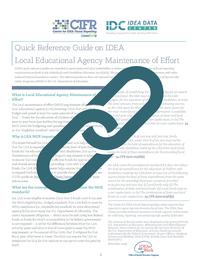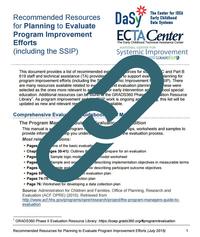Site Search
Results 8 - 11 of 11
Format: Reference Materials
Quick Reference Guide on Coordinated Early Intervening ServicesDeveloped by CIFR, in collaboration with IDC, this three-page quick reference guide assists states, LEAs, and stakeholders to better understand basic CEIS requirements stipulated in IDEA. The guide is updated to reflect 2016 changes in the IDEA Part B regulations on significant disproportionality. The guide describes the requirements for the provision of CEIS, the use of CEIS funds, the interaction of CEIS funds and local MOE reductions, and reporting obligations. It concludes with questions and additional resources for states to consider.
Format: Reference Materials
Quick Reference Guide on IDEA Local Educational Agency Maintenance of EffortDeveloped by CIFR, in collaboration with IDC, this three-page quick reference guide assists states, LEAs, and stakeholders to better understand the basic local MOE requirements stipulated in IDEA. The guide describes the consequences of failing to meet MOE, standards for calculations, allowable exceptions, and reporting obligations. It concludes with questions and additional resources for states to consider.
Format: Reference Materials
Recommended Resources for Planning to Evaluate Program Improvement Efforts (including the SSIP)This document provides a list of recommended existing resources for state Part C and Part B 619 staff and TA providers to use to support evaluation planning for program improvement efforts including the SSIP. The document focuses on resources that are more relevant to evaluation and evaluation planning for early intervention and preschool special education.
Format: Reference Materials
Significant Disproportionality (Equity in IDEA)These resources are a follow-up to the Equity in IDEA final regulation, which was published in the Federal Register on Dec. 19, 2016, and became effective on Jan. 18, 2017. The Q&A is a guidance document that includes questions and answers on the rule, including the standard methodology; remedies; effective and compliance dates; and a glossary of terms. It is intended to be used as a resource for states as they begin engaging with stakeholders around the implementation of the final rule. The Model State Timeline outlines the different streams of work and the timelines that states should consider as they implement the new rule.





